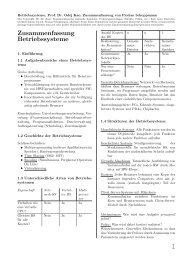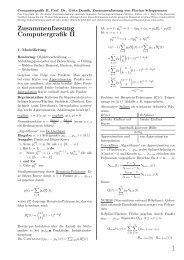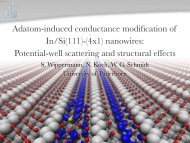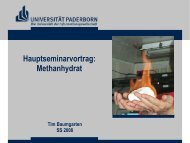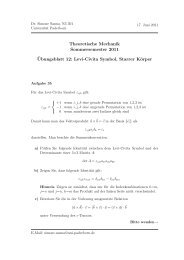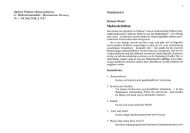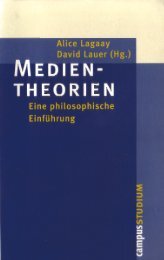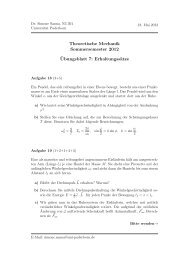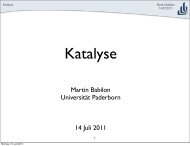Skript / lecture notes - Universität Paderborn
Skript / lecture notes - Universität Paderborn
Skript / lecture notes - Universität Paderborn
Erfolgreiche ePaper selbst erstellen
Machen Sie aus Ihren PDF Publikationen ein blätterbares Flipbook mit unserer einzigartigen Google optimierten e-Paper Software.
Prof. Dr. Wolf Gero Schmidt<br />
<strong>Universität</strong> <strong>Paderborn</strong>, Lehrstuhl für Theoretische Physik<br />
in dieser Hinsicht gewissermassen als Mittelwertbildung verstanden werden.<br />
Andererseits wäre es zu erwarten, daß der quantenmechanische Erwartungswert der Geschwindigkeit<br />
eines Partikels wieder den Ehrenfest´schen Theoremen und damit der<br />
klassisch-mechanischen bzw. relativistisch-mechanischen Abhängigkeit vom Impuls genügt.<br />
Um diese Aussage zu püfen, benutzen wir am besten die Darstellung der Operatoren<br />
im Heisenberg-Bild. Da die Kommutatoren im Schrödinger-Bild und im Heisenberg-Bild<br />
die gleiche mathematische Struktur besitzen ([Â, ˆB] = Ĉ =⇒ [ÂH, ˆB H ] = ĈH) folgen aus<br />
den im Schödinger-Bild gültigen Relationen [Ĥf , Ĥf ] = 0, [Ĥf , ˆ⃗p] = 0 und [H f , ˆ⃗x] = cˆ⃗α<br />
sofort die entsprechenden Relationen im Heisenberg-Bild According to this equation there<br />
are only the two eigenvalues ±c for the components of the velocity operator. Moreover,<br />
these components don not commute anymore and we cannot obtain 5.374 as nonrelativistic<br />
limit of 5.375. The relativistic particle follows a trembling motion with the<br />
instantaneous velocity components ±c. That we can indeed measure any velocity ∣ ˙⃗x<br />
∣ < c<br />
can possibly be explained from the fact that any velocity measurement is nonlocal as it<br />
corresponds to the limit υ = |∆x/∆t| ∆t→0<br />
and involves small, but finite time intervals.<br />
On the other hand, we expect to obtain the expectation value for the particle velocity<br />
from the Ehrenfest theorem. In order to probe that we most conveniently use the Heisenberg<br />
picture. It holds [Â, ˆB] = Ĉ =⇒ [ÂH, ˆB H ] = ĈH and therefore we immediately<br />
write<br />
[Ĥf , Ĥf ] = 0, [Ĥf , ˆ⃗p H ] = 0, [Ĥf , ˆ⃗x H ] = c i ˆ⃗α H (5.376)<br />
wobei wir berücksichtigt haben, daß Ĥf im Schrödinger- und Heisenberg-Bild eine identische<br />
Darstellung hat. Schließlich ist mit 5.232 Since Ĥf is identical in the Schrödinger<br />
and Heisenberg pictures. From 5.232 one obtains<br />
[Ĥf , ˆα µ ] = Ĥf ˆα µ + ˆα µ Ĥ f − 2ˆα µ Ĥ f (5.377)<br />
Für die ersten beiden Terme bekommen wir unter Beachtung der Antikommutatorbeziehungen<br />
für α- und β-Matrizen Using the anticommutator relations for α and β matrixes<br />
we find<br />
Damit Hence<br />
c(α ν α µ + α µ α ν )ˆp ν + mc 2 (βα µ + α µ β) = 2cÎδ µν ˆp ν = 2cÎ ˆp µ (5.378)<br />
[Ĥf , ˆ⃗α] = 2(cÎ ˆ⃗p − ˆ⃗αĤf ) also thus [Ĥf , ˆ⃗α H ] = 2(cÎ ˆ⃗p H − ˆ⃗α H Ĥ f ) (5.379)<br />
Die Kommutationsrelationen 5.376 liefern uns außerdem From 5.376 we see furthermore<br />
124




